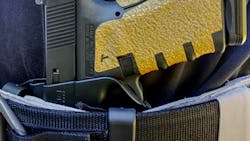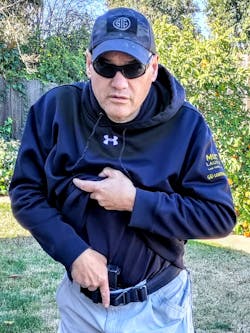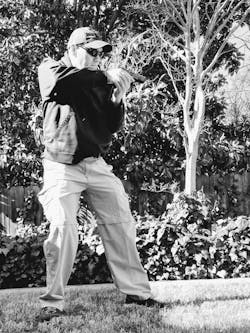The Emergence of Appendix Carry
Appendix carry has it’s advantages, but foremost is the ability to hide a big gun. Many users can put their duty gun into the waistband with no print, and present it quicker than any other carry system.
As you read through this article, be realistic. If your body style is not suited for appendix carry, don’t do it. I know that everything is supposed to be inclusive these days, but I’m not politically correct for everyone’s own good.
What Kind of Gun?
Originally the gun used for appendix carry was a “belly gun.” Most people think of modern revolvers with “bobbed” (reduced) hammers, but the belly gun concept existed in the black powder era, and an argument could be made for flintlock and percussion pistols as well. Plenty of Civil War era revolvers had their dimensions reduced so they could be carried in the front waistband.
The concept of the belly gun has had modern improvements. Foremost is a consistent positioning of the gun, which requires specific belt/holster combinations. It is important that officers recognize that appendix carry is a system, not a collection of components.
Design concepts have not changed. The best guns for appendix carry have smoothed edges and a lack of protrusions that could snag in the course of presentation.
Years ago, we published “12 Rules of Off Duty Conduct” (Law Enforcement Technology, February 2006). Rule 10 was “carry the most effective weapon the wardrobe allows.” This still applies.
Back in the dark ages of appendix carry, users would shave the front sight down, and sometimes remove the rear sight. There were some concealed carry guns that had trenches, or sight channels, rather than good sights.
The philosophy here is based on the premise that every firearm deployment is a close in combat situation. Statistically, this is more right than wrong, but not using sighted fire when it is a prudent, and generally considered correct, procedure is not reasonable conduct. Not training for sighted fire, or any conditions that the officer would be likely to encounter, could be negligent training, as in Popow v. City of Margate (476 F.Supp. 1237 (N.J. 1979).
If you missed the huge leaps in sight technology beginning in the 19’s, let me help you through the trends: Indestructible sights with quick sight acquisition are commonplace right now, and we owe pioneers like Wayne Novak (NovakSights.com) and Ed Pastusek and Ashley Emerson (XSSights.com) for them.
The current trend is to carry your duty sized gun, or a duty sized equivalent, for EDC. That is, if your duty gun is a Glock 17, carry a Glock 19 or Glock 43. Fortunately, SIG Sauer has made it easy because end users can swap a FCU (Fire Control Unit) to go from a P320RXP XCompact to the duty sized P320 RXP XFull-Size.
How to Train
Do you remember the "One and One Drill" in the April issue of Law Enforcement Technology (officer.com/21128477)? This drill is my standard on how I test and evaluate a holster, gun, or technique. This drill should be the standard on how to test any new equipment or technique.
Combat Drill
When it comes to close quarters shooting, the goal is to shoot quickly and accurately. The closer the target, the less time one must spend on accurate sight alignment. There are some firearms experts who will say, “All shots must be sighted”, and argue that point shooting should never be practiced. The truth is, point shooting has it’s place also. The purpose of this drill is to train the shooter to seek the goal of sighted fire, but shooting at “bad breath” distance doesn’t take lining up the sights.
Start with a holstered gun at contact distance from the target. At the “Threat” command, deliver a solid distraction strike on the target, then draw. Shoot while stepping backwards. The shooting pattern should be in a “zipline”, meaning the shooter fires from the level of the muzzle in a quick delivery while moving backwards and bringing the sights into the sighting plane. The retreat should go to the 7-10 yard line.
A completed target will have a vertical line of holes. Like any drill, run it slowly to insure smoothness first, then slowly increase speed.
What’s the lesson here? There is a zone where the gun comes up to the sighting plane and the shooter must use the sights, in order to engage the target. There is a zone where the shooter cannot engage while using sighted fire, or the threat is already inside the OODA loop. In the course of this drill, the shooter learns to set the goal of sighted fire, but recognize the GSP philosophy:
"A good plan violently executed now is better than a perfect plan executed next week."
- General George S. Patton
Short on Bullets?
If you’re short on practice bullets, which is par for the course right now, here is another drill that won’t burn through your supply.
Start at the 7-yard line with torso shaped (IDPA cardboard) targets faced 45 degrees from the firing line. In this manner, shooters have an oblique target, which is much harder to hit. On the “threat” command, the shooter must move, draw from concealed, shooting one head shot on target within 3 seconds. Again, smooth presentation and correct technique is the critical part of this drill.
The draw from concealed par of appendix carry is different. Actually, clearing the clothing part is similar, except it is in front, and not on the side, of the shooter. When it comes to clearing clothing, some like to lift from the bottom, exposing the gun fully, others like to grab a handful near the gun and lift. I like something in between, but the non-firing hand needs to end up at sternum level.
The other big difference is the fact that the gun is drawn, it is parallel to the body, and needs to be rotated in order to get it on target. One way to do this is to draw into something that looks like position sul, or a compressed ready position. The gun is raised up to the sternum level, where it meets the support hand, and punches out toward the target.
If you are an optics user, the gun must come up to nose, not sternum, level, then punch straight out in the sighting plane.
This is the reason why shooters must acquire this drill smoothly. If done incorrectly, the muzzle crossing the non-firing hand or the body exists. This is another reason why some instructors, including me, are reluctant to let some shooters use this technique on their range.
A word about reholstering: The rule is always reholster reluctantly. With appendix carry, this is critical. Holster your gun slowly. Don’t be afraid to look down and stop and think about it.
What Kind of Holster?
The first rule of holster purchase is to have something that agrees with training, policy, and common sense. Second, choose a holster that covers the entire trigger guard. Most shooters go for something that covers as much of the gun as possible, except areas that allow a good Master Grip.
I know that many of you are not carrying a gun with an optic right now. However, plan for it. Pick a holster that already has a recessed area that allows an optic. Most holsters have this already.
Look for open bottom holsters with well contoured edges. This is the difference between a bargain holster and a really good one. Wearing a cheap one will give the user all day scars from sharp edges. Why open bottom? First, they will be shorter, and therefore there is less to dig into the leg, or between the legs. Second, this will allow a threaded barrel, and therefore a multitude of different assignments over one’s career.
Good appendix holsters have big mouths and molded retention. While I prefer to have a high sweatguard close to the body, I also like them to be so oversized that they could never fit inside the trigger guard. I have provided some photos from my appendix carry collection. Of the holsters I have, I prefer my Bravo Concealment Torsion holster. It is a flexible platform. It can make my Glock disappear. This holster can be used with a single tuckable clip, or both included clips. When used with only one clip, the other acts as a “wing”, which presses the butt of the gun into the body, making it more concealable.
Holster manufacturers have different versions of the wing, which is a feature designed to rotate the butt of the gun into the body. Look for bumps or wings on the holster body to find this feature.
Some officers have taken to using optics for on or off duty, for which I vote “yes.” Others prefer firearm mounted lights, for which I give an “OK,” but not my personal preference. Bravo Concealment can accommodate both.
Many users like to “sidecar” their magazine holders. Use the Bravo Concealment Torsion Super Combo pack, which comes with a magazine holder that can attached to the holster.
Appendix Carry is Inherently Dangerous
If carried in the typical appendix carry fashion, the muzzle rests over the femoral artery, or other inherently sensitive areas.
I know someone who runs a CCW school who does not allow his students to employ appendix techniques. The truth is, this is not a beginning student technique. Firearms training has a lot of components that eventually need to become integrated. If the student is trying to learn several skills at the same time, one of them should not be appendix carry. Having said that, thousands of users employ appendix carry every day, including all thumbs people like me.
Appendix Carry is Safer
One of the most important aspects of appendix carry is the fact that we are all stronger and exhibit the most coordination in the centerline of our body. Wrestlers apply holds from their centerline. We fight, and do magazine changes from our centerline. It is only a natural progression to perform a draw from the centerline.
I do not advocate SOB (small of back) carry at all, simply because it does not provide a consistent presentation. Having said that, some users do this rather well. I know way too many casual CCW carriers who are lightning fast with appendix carry.
Will my Techniques Change?
The short answer is, “They’d better not.” If you carry method disagrees with your training, or requires you to modify an appropriate, successful, and proven method, it is time to look at another method. This rule should apply to anything firearms related.
About the Author

Officer Lindsey Bertomen (ret.), Contributing Editor
Lindsey Bertomen is a retired police officer and retired military small arms trainer. He teaches criminal justice at Hartnell College in Salinas, California, where serves as a POST administrator and firearms instructor. He also teaches civilian firearms classes, enjoys fly fishing, martial arts, and mountain biking. His articles have appeared in print and online for over two decades.


